Understanding the best diet for Huskies is crucial for their health and well-being. Despite their wolf-like appearance, Huskies are not as selective in their eating habits as their wild counterparts and are generally not picky eaters.
This trait can make feeding them easier for you, but it also means you need to be vigilant about their diet to prevent obesity or consuming harmful foods. So, what should you feed your Husky to ensure they stay healthy and thrive?
Huskies thrive on a diet rich in high-quality proteins like chicken, beef, and fish, which support their muscular build. Including healthy fats, particularly omega-3 fatty acids from fish oil, is essential for energy and coat health. Incorporating complex carbs such as brown rice and sweet potatoes can also provide sustained energy.
Their diet should also include dog-safe fruits and vegetables for necessary vitamins, minerals, and fiber. You should avoid providing foods with excessive fillers and additives and ensure they have constant access to fresh water.
Let’s dive into the recommended dietary guidelines for this energetic and resilient breed.
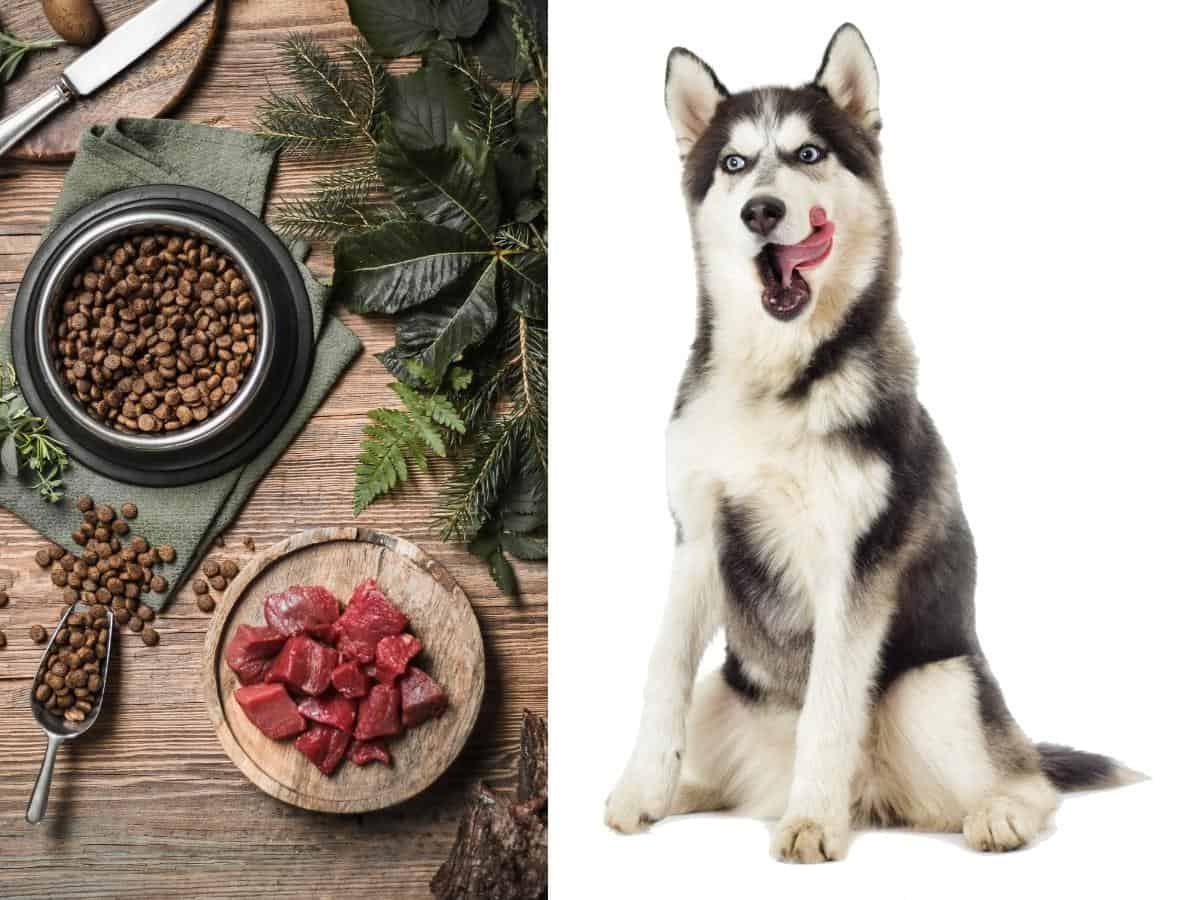
Nutritional Requirements for Huskies
Huskies are medium-sized dogs, which means they need more protein than smaller breeds. But they also need a decent amount of healthy fats and carbs.
Considering Huskies were developed as working dogs, they need an excellent diet to sustain their energetic needs.
Huskies need a high-quality, protein-rich diet of 18-22% protein. They can also derive nutrients from grains, fruits, and vegetables. However, Huskies must ensure they have the right balance of protein, fats, vitamins, minerals, and fiber to sustain their endless energy.
Knowing the macronutrients your Husky needs is crucial to getting him food to support his growth and help maintain his physique. Without the correct ratio of protein to fat or protein to carbs, your dog might get obese or become undernourished.
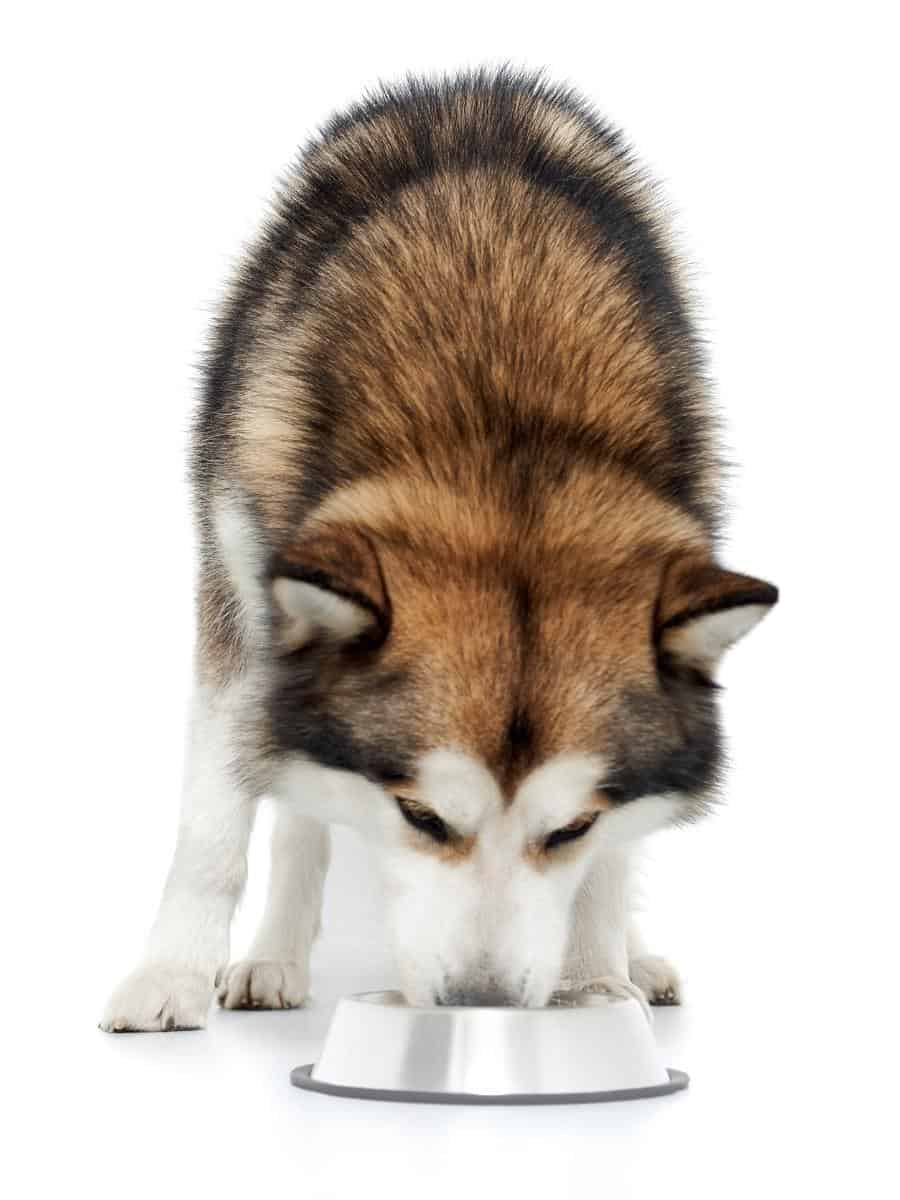
What you feed your Husky also depends on its age. Puppies, adults, and seniors all have different nutritional needs.
When reading pet food labels, you need to choose a food pattern according to your dog’s life stage. You can supplement a Husky’s meal plan with multivitamins, joint support, and probiotics.
The Association of American Feed Control Officials (AAFCO) determines the minimum requirements for the nutritional adequacy of dog food. The AAFCO documentation can be a bit of a heavy read, but here’s my simplified version:
| Life Stage | Protein (Minimum) | Fat (Minimum) |
|---|---|---|
| Gestation/Lactation | 22% | 8% |
| Growth (puppies) | 22% | 8% |
| Adult Maintenance | 18% | 5% |
| All Life Stages*** | 22% | 8% |
***A Husky’s food requirement designed for “all life stages” simply means one that meets the nutritional requirements for any life stage, whether reproduction, growth, or adult.
Other age-related feeding considerations are:
- Husky Puppies – As Huskies are prone to hip dysplasia, they mustn’t have too much excess calcium in their diet when growing, as this can increase the risk of joint issues in later life.
- Senior Huskies – Some older dogs need more protein than their younger counterparts and may benefit from a diet with a higher protein-to-calorie ratio. Always check with your vet first for the best way for your pet.
Your Husky’s meal plan will also have distinct nutritional needs depending on size, activity level, and overall health. For example:
- A lively and growing Husky puppy may need twice as many calories as an adult.
- A pregnant or breastfeeding bitch will need significantly more calories.
- A senior Husky may need 20% fewer calories in their diet than middle-aged dogs.
Fortunately, dog food manufacturing has reached the point where you don’t have to curate your dog’s diet like a Hollywood actor trying to lose 20 lbs for a role.
List of Foods Huskies Can Eat
To select the best food items for your Husky, whether feeding a homemade diet or treats, you need to know your options.
Huskies can eat most meat/protein, including lamb, beef, chicken, turkey, pork, fish, and eggs. They can also consume plant-based proteins such as grains, legumes, and veggies. Bits of fruit, aside from grapes and raisins, are also good.
We’ll review grapes and grape-adjacent fruits/products in this post’s “can’t eat” section. But first, let’s explore each food option that Huskies can eat in their diet.
Fish
Huskies can eat fish, which is typically pretty healthy and often used as an alternate protein source in dog food. Sardines seem to be the lowest-risk fish for a dog as they are a good source of Omega-3. You can also feed your Husky salmon, cod, whitefish, tuna, and mackerel.
Fish can carry parasitic bacteria that are usually killed in the cooking process. Moreover, fish bones can be an obstacle, and deboned fish can be expensive. Nonetheless, my dog loves a little tuna or salmon as a topping on her food. Still, fish should not be the main protein in your dog’s diet, but it is a great addition.
Lamb
Huskies can eat lamb, a holistic primary food source for a dog. It contains essential amino acids and dietary fat to sustain growth and energy and build healthy muscles, skin, and coats. It also contains vital vitamins and minerals and is easy for dogs to digest.
With a few fruit-driven carbs in your Husky diet, he can survive on an entirely raw and organic diet if your wallet can survive this feeding choice. You can, of course, choose to cook the meat if you prefer.
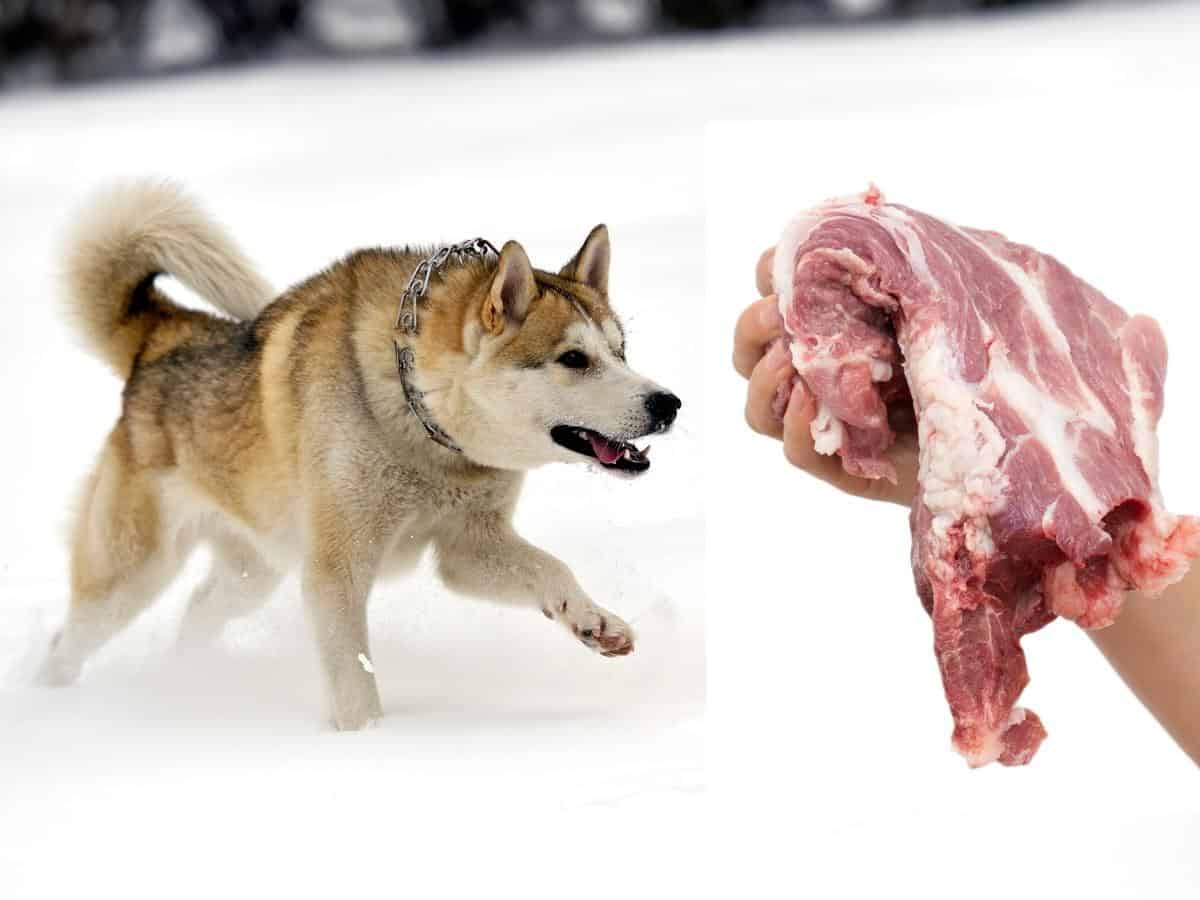
Beef
Huskies can eat beef. Beef is an excellent protein source and is found in many dog foods. It contains various nutrients such as vitamin B6, B12, selenium, zinc, iron, riboflavin, and phosphorus. Beef helps maintain and build muscle mass in dogs and prevents anemia.
Beef and lamb don’t differ as much in their macro nutritional value. They differ in taste and price. You can test to see which of the two your pup prefers. But just like a lamb diet, you’ll need external carbs, primarily from fruit or veggies.
Chicken
Huskies can eat chicken. Chicken (and turkey) are an excellent protein source, providing energy, strong bones and muscles, and abundant essential vitamins and minerals. It also has Omega-6 fatty acids, which are good for your Husky’s coat and skin.
Chicken and turkey are primary ingredients in commercial dog food and are gentler on your wallet than lamb or beef. But, if you want the best for your dog, avoid chicken meal and by-products.
Eggs
Eggs are incredibly nutritious for your Husky. They are rich in amino acids, the building blocks of protein. These nutritional powerhouses also contain many nutrients, including iron, vitamin A, B2, B5, B12, folate, phosphorus, calcium, zinc, selenium, and fatty acids.
You can feed eggs raw, but consult your vet first and follow all food safety guidelines to prevent the risk of contracting salmonella.
Grains
Huskies can eat grains such as rice, whole wheat, oats, and corn, and as omnivores, they can thrive on a grain-inclusive diet. Grains contain abundant nutrients and provide carbs, fat, and antioxidants that support a healthy immune system, skin, and coat.
Some grains are more nutritious than others. For example, choose brown rice instead of white, except if your dog has diarrhea, then feed white rice as it binds the stools.
| PROTEINS | GRAINS |
|---|---|
| Beef | Wheat |
| Chicken | Rice |
| Turkey | Oats |
| Venison | Oatmeal |
| Pork | Corn |
| Lamb | Maize |
| Duck | Rye |
| Liver | Quinoa |
| Kidney | Buckwheat |
| Heart | Barley |
| Fish | Teff |
| Salmon | Amaranth |
| Tuna | Millet |
| Mackeral | Spelt |
| Eggs | Bulgar |
Don’t be sucked into the hype created by some pet food brands that grains cause allergies in dogs, and dogs should eat grain-free.
The reality is that food allergies in dogs are rare, and dogs are more likely to react to protein sources such as beef, chicken, or lamb.
Fruits
Huskies can eat fruits such as apples, strawberries, bananas, pears, or raspberries, but no matter how vegan you are, please do not make your dog survive on fruits alone.
Since fruits have an average of 2% to 6% protein, they cannot replace the protein in meat.
Fruits should be more of a carb supplement in your dog’s diet. Above all, avoid feeding grapes, raisins, and other dried variants to your dog.
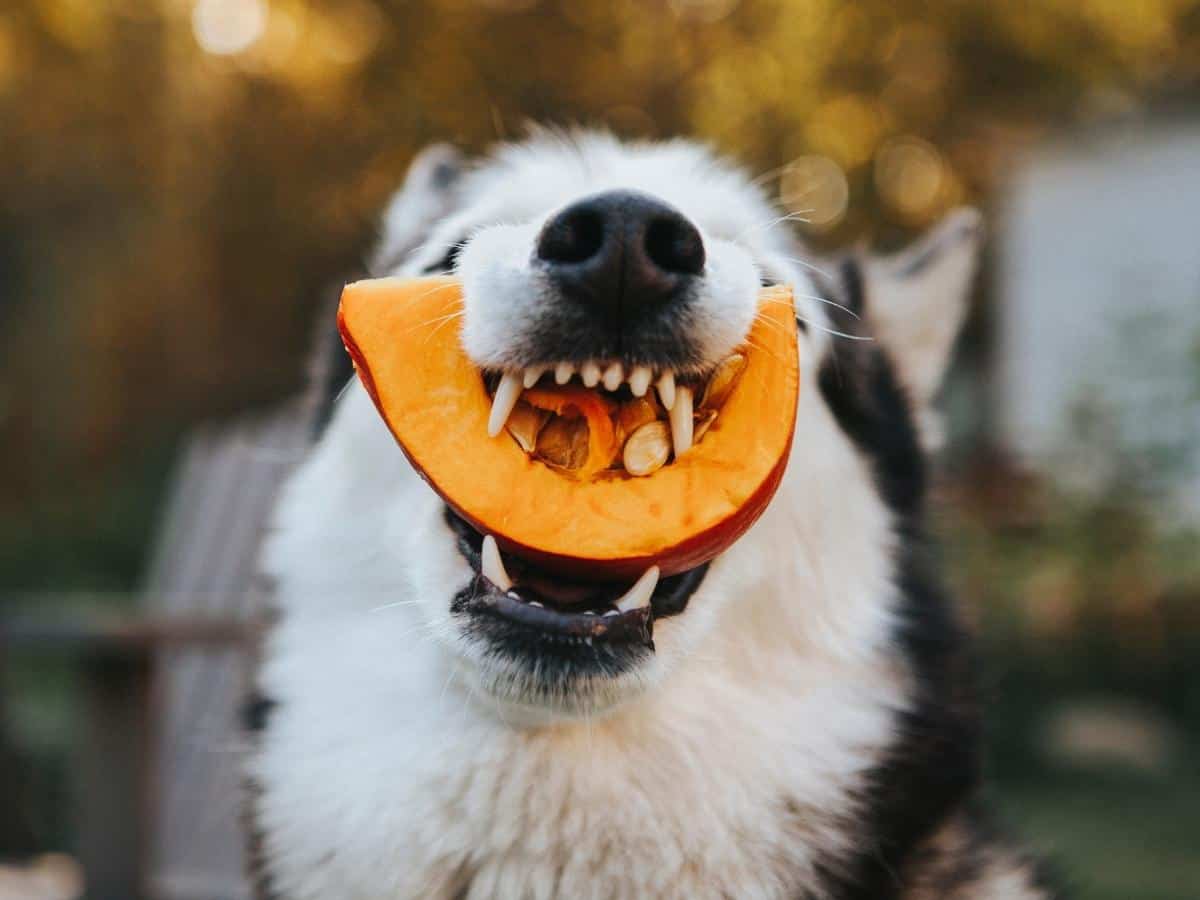
Vegetables
Huskies can eat vegetables such as green beans, carrots, pumpkin, peas, and sweet potatoes. Although they are carb-rich, they have more protein than fruits. Still, their macronutrient ratio is not enough to offset meat in a dog’s diet, but it can be used as a carb supplement, just like fruits.
Huskies don’t have a breed-wide favorite veggie, and you’ll have to try various vegetables to discover what your Husky loves the most.
| VEGETABLES | FRUITS |
|---|---|
| Artichoke | Apple |
| Asparagus | Apricot |
| Bell Peppers | Banana |
| Beets | Blackberries |
| Broccoli & Brussels Sprouts | Blueberries |
| Cabbage & Cauliflower | Coconut |
| Carrot | Cranberries |
| Celery | Cucumber |
| Corn | Dates |
| Cucumber | Kiwi Fruit |
| Eggplant | Mango |
| Green Beans & Peas | Melon |
| Lettuce & Kale | Nectarine |
| Parsnips | Peach & Plum |
| Pumpkin | Persimmon |
| Potato (cooked) | Olive |
| Rutabaga & Turnip | Pear |
| Spinach | Pineapple |
| Sweet Potato | Raspberries |
| Squash | Strawberries |
| Zucchini | Watermelon |
Dairy
Huskies can eat some dairy foods in moderation if they are not lactose intolerant. Some lactose-intolerant Huskies have trouble digesting milk but can enjoy small amounts of cheese and plain yogurt. Dairy foods provide protein, calcium, vitamin D, A, B12, zinc, magnesium, and selenium.
Experimenting with small amounts is best to see what your dog can handle. For example, my dog loves small chunks of cheddar cheese as treats but cannot tolerate heavy cream, although she is okay with a few tablespoons of milk occasionally.
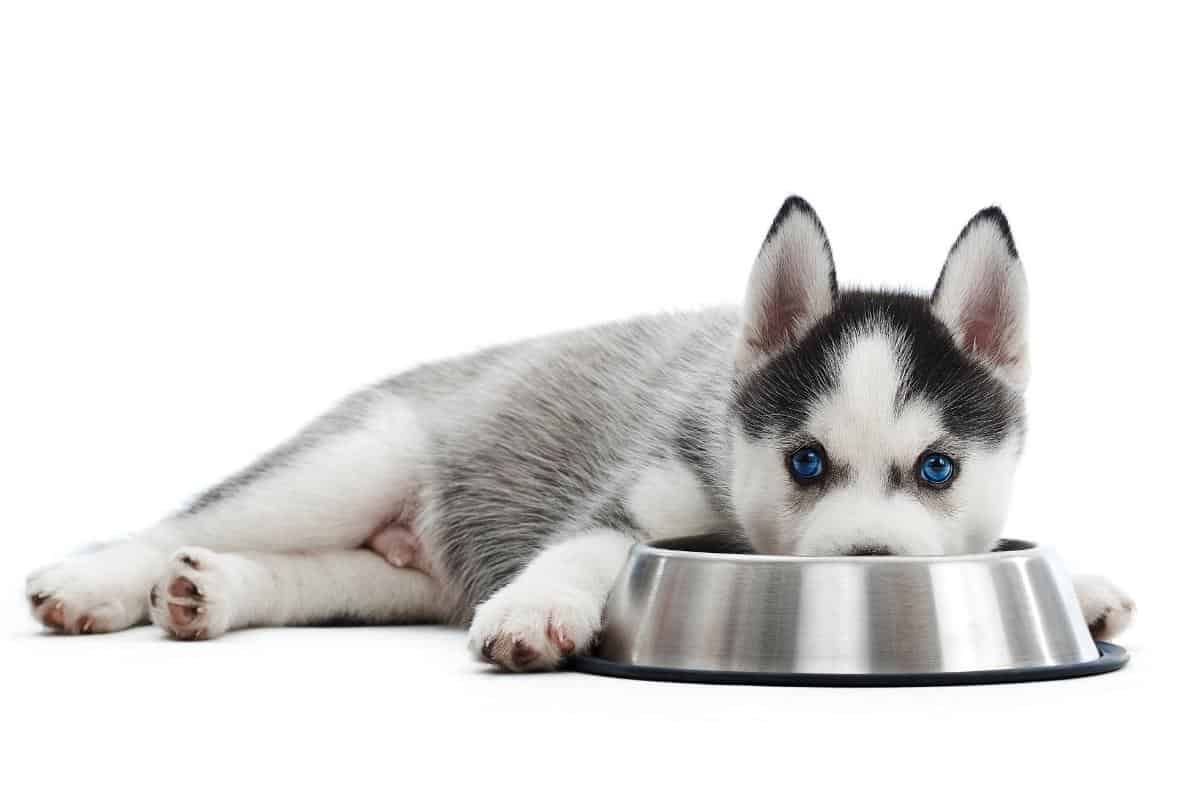
List of Foods Huskies Cannot Eat
Huskies cannot eat onion, garlic, grapes, raisins, chocolate, or avocado. Moreover, you should keep alcohol, sugar, and caffeine out of a Husky’s diet. Nuts, in general, should not be in your dog’s diet, and you should ensure that any fruit pits are out of your dog’s reach.
The table below covers why you must avoid each “must avoid” food.
| Food | Reasons Your Husky Should Not Eat It |
|---|---|
| Raw fish | Raw fish can carry parasites, and big fish often contain too much mercury. Standard market-packed sardines are the safest fish for a dog. |
| Onion | Onion can kill red blood cells in a dog. Even onion powder in a broth can have this effect. |
| Garlic | Garlic can make your dog anemic. Make sure any food you prepare contains no garlic flavor. |
| Chocolate | Theobromine and caffeine in chocolate and chocolate-adjacent products are toxic to dogs. |
| Sweeteners | Products like peanut butter may have Xylitol, which can drop a Husky’s blood sugar. Ensure you choose organic. |
| Grapes & Raisins | The biological cause of grape toxicity is yet to be discovered. Still, enough cases of canine kidney failure following grape consumption have been documented to keep them on the “must avoid” list. |
| Nuts | Nuts in excess can lead to vomiting and tremors. Macadamia and Tree Nuts are the worst at this. |
| Cooked bones | These can cause constipation because a Husky’s stomach cannot digest cooked bones. Raw bones are fair game, though, as long as they’re wider than the muzzle. |
| Avocado | The avocado skin can result in episodes of vomiting, so your Husky should be kept away from this fruit. |
| Alcohol | Keep alcohol out of your Husky’s reach because dogs can’t digest alcohol. As a result, your dog can OD on alcohol. |
| Fruit pits | When you feed fruit to your Husky, you need to make sure that you remove the pits as they can block your dog’s intestines or cause choking. |
| Sugar | Dogs love sweet treats, but if you feed your dog a sugar-rich diet, he will get fat. If you don’t want your Husky to look like a middle-aged, recently divorced wolf, you should keep sugar and sugary treats out of his diet. |
| Yeast Dough | If you bake bread at home, keep your Husky away from the unbaked dough. It can ferment in the stomach causing alcohol toxicosis, and the yeast can rise in the gut, causing a severe blockage. |
| Moldy Food | Mold contains mycotoxins that are poisonous to canines, so don’t be tempted to give your dog blue cheese or moldy bread – and keep him away from the garbage. |
The list of “must avoid” foods leaves you with two options. The first is to sit down and curate a Husky diet that dodges the above. The second is to simply opt for packaged dog food.
The problem with curating an organic diet for your Husky is that many allowed foods are contradictory. You can feed your dog fruits, but keep the pits away. You can provide your dog with potatoes that aren’t green or uncooked.
Moreover, specific fruits can be toxic to your Husky, especially grapes and starfruit. Similarly, you can feed your dog veggies, yet garlic and onion can be problematic. You can provide your dog fish, but not if it is completely raw (untreated/uncooked).
But organic food is healthier than extruded kibble cooked at high temperatures, thus reducing some nutritional value. On the other hand, packaged dog food is easy to get, feed, and store. It seems like the overall balance one should maintain is as follows.
Best Types of Dog Food For Huskies
The ideal diet for Huskies should include breed-specific packaged dog food complemented by fresh meat. Additionally, incorporating Husky-friendly fruits and vegetables as supplements can be beneficial.
This dietary regimen should be paired with an appropriate level of physical activity suitable for the breed.
Now that we have covered specific foods that Huskies can and can’t eat, let’s look at the types of dog food you can feed your Husky.
Dry (Kibble)
Feeding a Husky with high-quality dry dog food or kibble is a practical choice for providing a balanced diet. Good kibble includes essential nutrients like proteins, fats, and vitamins, catering to the Husky’s high-energy needs.
Its crunchy texture also promotes dental health. When selecting kibble, you must choose formulas with high-quality ingredients and high protein content, suitable for the Husky’s active lifestyle.
Other pros of kibble are that it is less expensive, lasts longer, and doesn’t need refrigeration.
Wet (Canned)
You can try wet dog food if your Husky turns his nose up at dry kibble. Some larger dogs like it, whereas others prefer a bit of crunch. Take note, though, that canned wet food can be expensive for dogs the size of Huskies, as you will need to provide much more.
Ensure you check the protein content, as wet food contains a lot of water. But it may suit dogs that don’t drink much water or have urinary problems.
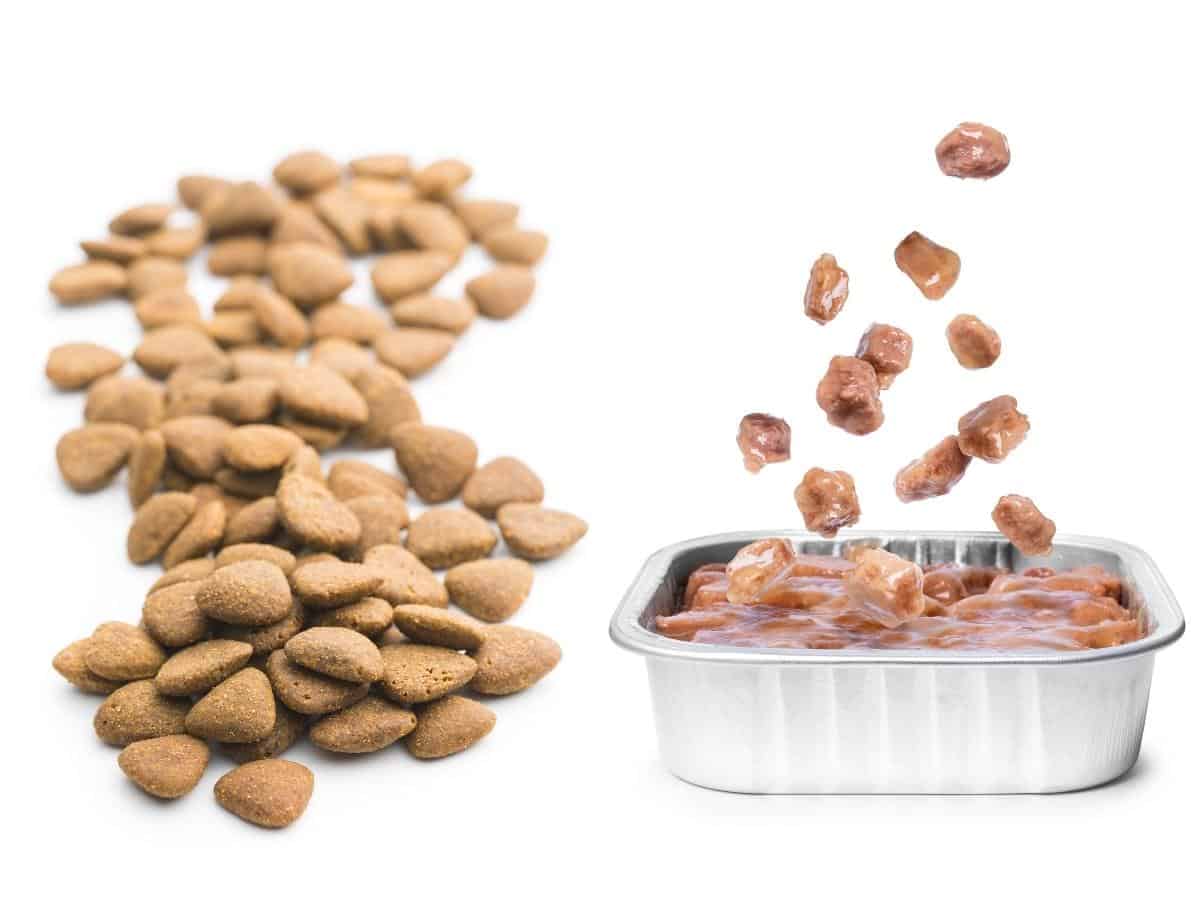
Dry and Wet Mix
This is one of the most widely preferred Husky food types, and you get the best of both worlds. Most Huskies who dislike dry or wet food like a wet and dry mix.
Adding a few scoops of wet food to soften dry food changes the texture and palatability of the food, making it enticing to your dog.
Another alternative is to add a topping to kibble, such as some chicken, beef, fruit, veggies, cheese, or plain yogurt. This gives your dog variety, but remember to adjust the calories accordingly.
You may also consider semi-moist dog food. However, it’s uncommon as it offers the least nutritional value, is expensive, and comes with added sugar and salts to preserve shelf life and moisture.
Homemade
Wet dog food isn’t the exclusive domain of factories. You can use one of countless dog chow recipes to produce homemade dog food.
Some dog owners enjoy home cooking for their besties, giving them complete control of what they feed their dogs. However, it can also be expensive and very time-consuming.
If you want to be a home feeder, you should consult a canine nutritionist to check your Husky isn’t missing out on any vital nutrients. Check out the American College of Veterinary Nutrition, as they have a directory of certified vet nutritionists.
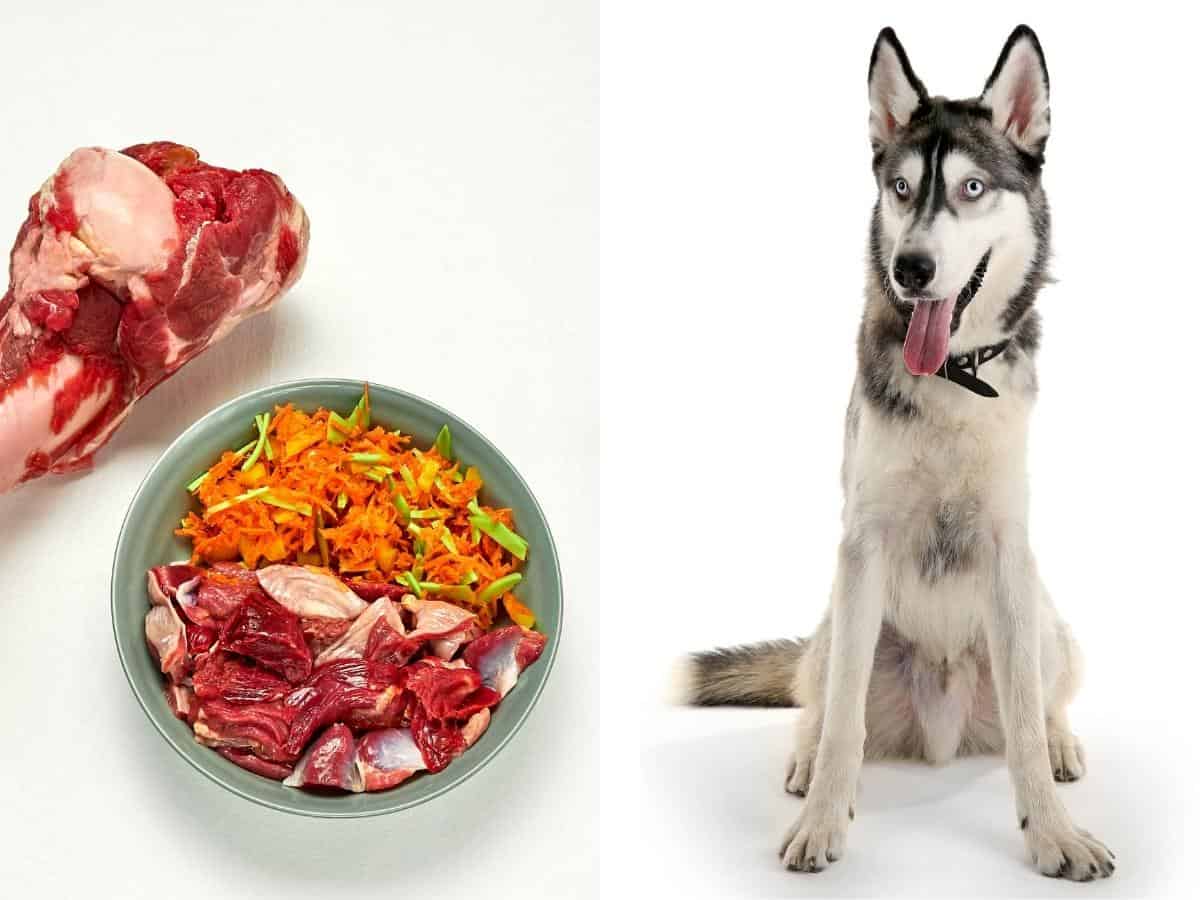
Raw
Of course, if you grasp the idea of feeding chow made from leftover meat, you can always get your Husky a prime Wagyu steak.
A raw food diet consists of raw meat and organs mixed in and raw bones. This method of feeding your dog has grown in popularity over the past decade.
You can prepare a raw diet at home, similar to a home-cooked meal (except raw), or buy pre-prepared complete and balanced raw food, which is more convenient.
If you choose to prepare a raw diet yourself, again, you’ll need to check you’re providing all the right foods in their correct proportions with your vet or a doggy nutritionist.
Dehydrated
Dehydrated dog food (air-dried) is often confused with dry dog food because it is technically dry. However, one must add water to get the food into the shape it is intended to be served.
A dehydrated doggy diet is a healthy and minimally processed feeding option as it uses a low-heat and gentle drying method.
It combines the convenience of dry food with the nutritional benefits of raw. It is easier to store and far more portable but it can be costly.
Freeze-Dried
Freeze-dried dog food is prepared at the factory and brought into its wet form, then freeze-dried into solids that pretty much dissolve into the water. It is basically dehydrated at a lower temperature.
This way, the nutrients are relatively undamaged, making this diet seemingly the most “organic” form of dry dog food on the market.
Once the food is put in a sealed package, it can take years to degrade because there is no moisture for microorganisms to survive. When you buy freeze-dried dog food, it is still raw. However, it isn’t cheap and is out of reach for most owners’ budgets.
Learn More About Dog Food Types In This Video…
Ideal Food Quantities For Huskies
Your Husky’s food needs will largely depend on his size, age, activity level, metabolism, and overall health.
For example, a working Husky will burn thousands of calories daily by pulling sleds, but a companion Husky in a warmer climate will need far less calorie intake.
Here’s a rough guide for a companion Husky with a moderate amount of daily exercise:
An adult male Husky needs 2 cups of dog food daily, one per meal. A smaller adult female needs 1.75 cups of dog food split into 2 meals. A Husky puppy needs 12 – 16 ounces of food per day divided into 3 meals initially and then 2 meals as he grows older than 6 months.
There’s no easy answer to how much to feed your Husky, but if you follow the packaging guidelines, you won’t go far wrong.
In any case, Huskies are not generally greedy or food-motivated dogs, so if you inadvertently underfeed him, you might find that he will let you know if he’s hungry!
Siberian Husky Feeding Schedule
A Siberian Husky’s feeding schedule is less complex than other dog breeds. An adult Husky can stop eating when he is full.
Nonetheless, giving him one cup of dry dog food or its equivalent, then waiting 8 hours before adding another cup to his bowl, is advisable to prevent Gastric Dilatation and Volvulus (bloat), to which Huskies are prone.
When your Husky is a puppy, you must split his intake into 3 or 4 meals. Feeding your pup is slightly complicated because of your, and not his, schedule.
You should wait at least 3 hours before introducing the next serving to a puppy’s bowl. Just avoid feeding your dog right before or after a period of high activity.
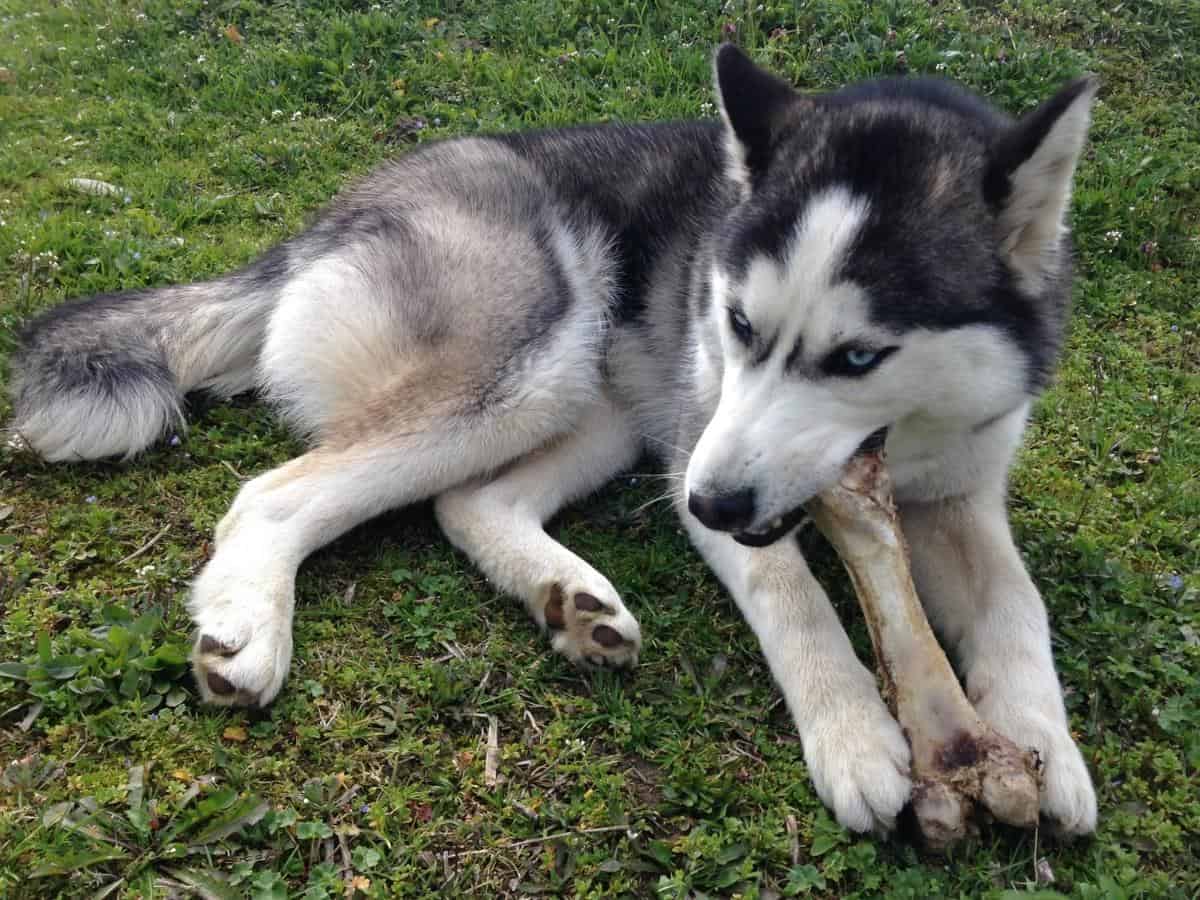
Husky Puppy Meal Plan
Husky puppies should be fed 4 meals a day up to 3 months, 3 meals a day up to 6 months, and 2 meals a day from 6 months to adulthood.
| Age of Husky | Daily Meals |
| 6 to 12 weeks | 4 |
| 12 to 24 weeks | 3 |
| 24 weeks onwards | 2 |
FAQs
What protein sources are best for Huskies?
The ideal protein sources for Huskies include lean meats like chicken and turkey, offering high-quality protein with low fat, and fish such as salmon and trout, rich in omega-3 fatty acids for healthy skin and coat. Eggs are also beneficial, providing both protein and essential nutrients.
For those with dietary restrictions or allergies, plant-based proteins like lentils and quinoa are excellent alternatives.
Can I give my Husky homemade meals instead of commercial dog food?
Yes! While commercial dog food is formulated to meet the nutritional needs of dogs, homemade meals can be a great alternative for Huskies. When preparing homemade meals, ensure they contain a balanced mix of proteins, carbohydrates, and healthy fats.
You should consult with a veterinarian or canine nutritionist to ensure your Husky’s specific dietary needs are met.
Final Thoughts
The ideal diet for Huskies focuses on high-protein food, as they are adept at regulating their food intake but not at avoiding harmful foods. Proper nutrition is also crucial for their health and recovery from illness or injury.
When selecting food for your Husky, consider their life stage, choose a dog food that fits your schedule, and opt for the highest quality you can afford.
Related Posts You May Like:





